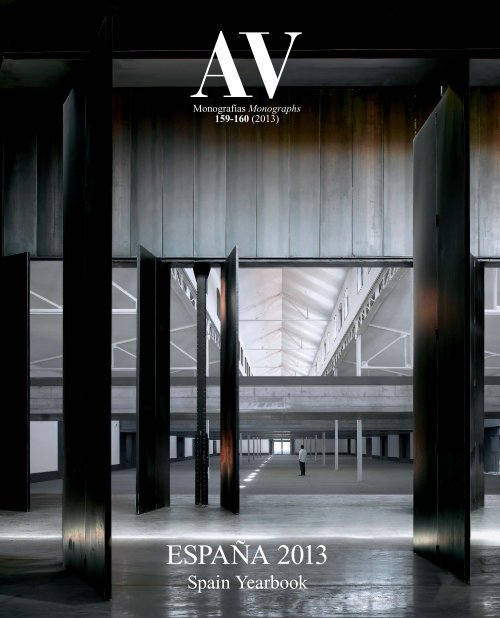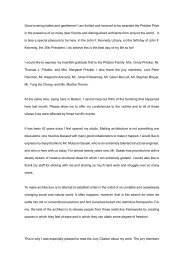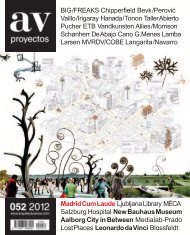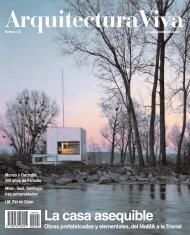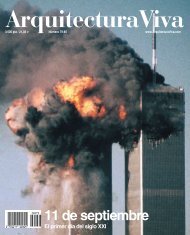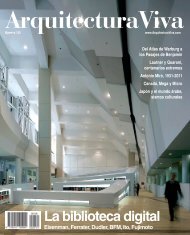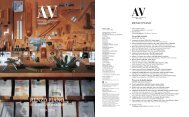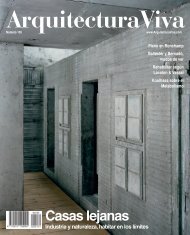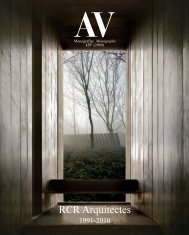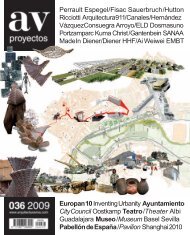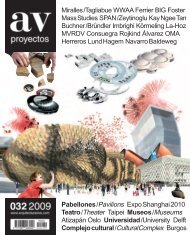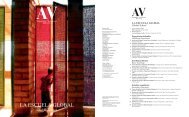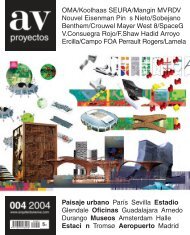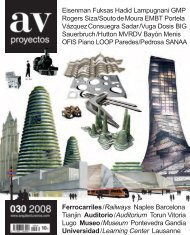AV MonografÃas 159-160_ESPAÃA 2013 - Arquitectura Viva
AV MonografÃas 159-160_ESPAÃA 2013 - Arquitectura Viva
AV MonografÃas 159-160_ESPAÃA 2013 - Arquitectura Viva
- No tags were found...
Create successful ePaper yourself
Turn your PDF publications into a flip-book with our unique Google optimized e-Paper software.
<strong>AV</strong>Monografías Monographs<strong>159</strong>-<strong>160</strong> (<strong>2013</strong>)ESPAÑA <strong>2013</strong>Spain Yearbook
<strong>AV</strong>Monografías Monographs<strong>159</strong>-<strong>160</strong> (<strong>2013</strong>)ESPAÑA <strong>2013</strong>Director EditorLuis Fernández-GalianoDirector adjunto Deputy DirectorJosé Jaime S. YusteDiagramación/redacción Layout/EditorialCuca FloresEduardo PrietoPablo del SerMaite BáguenaDavid CárdenasRaquel VázquezIsabel RodríguezMaría NúñezAna OlalquiagaCoordinación editorial CoordinationLaura MulasGina CariñoProducción ProductionLaura GonzálezJesús PascualAdministración AdministrationFrancisco SolerSuscripciones SubscriptionsLola GonzálezDistribución DistributionMar RodríguezPublicidad AdvertisingCecilia RodríguezTeresa MazaEditor Publisher<strong>Arquitectura</strong> <strong>Viva</strong> SLCalle Aniceto Marinas, 32E-28008 Madrid, EspañaTel: (+34) 915 487 317Fax: (+34) 915 488 191<strong>AV</strong>@<strong>Arquitectura</strong><strong>Viva</strong>.comwww.<strong>Arquitectura</strong><strong>Viva</strong>.com<strong>AV</strong> Monografías es miembro de ARCEPrecio en España 50 e© <strong>Arquitectura</strong> <strong>Viva</strong>Enero-abril <strong>2013</strong>Esta revista recibió una ayuda a la edición delMinisterio de Educación, Cultura y Deporte en 2012Todos los derechos reservados All rights reservedDepósito legal Legal registration: M-12104-<strong>2013</strong>ISSN: 0213-487XISBN: 978-84-616-3996-0Impresión Printing: Artes Gráficas PalermoCubierta CoverMatadero Madrid: Nave 16 y Casa del Lector(© Roland Halbe)Traducciones TranslationsLaura Mulas, Gina CariñoBalance del año Summary of the YearLuis Fernández-Galiano4 Naciones en naufragio Sinking Nations10 El planeta urbanizado An Urbanized Planet12 De la austeridad a la solidaridad From Austerity to Solidarity18 2012, una antología 2012, an AnthologySendas nuevas New Paths28 Centro de Creación Matadero, Madrid Matadero Contemporary Art CenterAutores varios Various Authors54 Colegio Oficial de Arquitectos, Madrid Institute of ArchitectsGonzalo Moure62 Centro cívico, Palencia Civic CenterExit Architects70 Espacios urbanos, Palma de Mallorca Urban SpacesFerrer Forés & VilanovaPiezas institucionales Institutional Pieces78 Centro de Creación Contemporánea, Córdoba Contemporary Creation CenterNieto & Sobejano88 Filmoteca Española, Pozuelo de Alarcón (Madrid) Spanish Film LibraryVíctor López Cotelo94 Edificio del Consejo Consultivo, Zamora Advisory Board BuildingCampo Baeza, F. Lorenzo, Redondo, G. Gaisán & Blanco100 Sede de la FEDA, Albacete FEDA HeadquartersCor & AsociadosMarcos de reunión Meeting Grounds108 Palacio de congresos, Toledo Congress CenterRafael Moneo118 Palacio de congresos, Sevilla Congress CenterGuillermo Vázquez Consuegra128 Teatro Ramos Carrión, Zamora Ramos Carrión TheaterMGM136 Centro cívico y cultural, Badalona (Barcelona) Civic and Cultural CenterMartínez Lapeña & TorresSaberes materiales Material Knowledge144 Plaza Mayor de la UAM, Madrid UAM Main SquareMTM152 Facultad de Economía y Empresa, Pamplona School of Economics and BusinessJuan M. Otxotorena<strong>160</strong> Centro de Magisterio, Granada Teacher Training SchoolRamón Fernández-Alonso168 Escuela de Arte y Diseño, Amposta (Tarragona) School of Art and DesignSebastian & PuigÁmbitos científicos Scientific Spaces176 Parque Científico, Espinardo (Murcia) Science ParkRetes Arquitectos182 Edificio E8, Vitoria E8 BuildingColl-Barreu Arquitectos188 Centro de interpretación, Pamplona Interpretation CenterAlday & Jover194 Centro neuropsiquiátrico, Zaragoza Neuropsychiatric CenterJosé Javier Gallardo | G///bangVariantes residenciales Residential Variants202 Viviendas sociales, Mieres (Asturias) Social HousingAmann, Cánovas & Maruri210 Conjunto Can Bisa, Vilassar de Mar (Barcelona) Can Bisa ComplexBatlle & Roig216 Viviendas sociales, Salou (Tarragona) Social HousingToni Gironès222 Viviendas sociales, Ceuta Social HousingInter National DesignUn año en el mundo A Year in the WorldLuis Fernández-Galiano230 Doce meses en portadas de prensa Twelve Months in Press Covers242 2012 en doce edificios 2012 in Twelve Buildings250 Premios y pérdidas Distinctions and Disappearances
Luis Fernández-GalianoNaciones en naufragioSinking NationsLa crisis institucional esla protagonista de un añomarcado por catástrofesnaturales, mudanzaspolíticas, hitos deportivosy logros científicos.The institutional crisismarked a year whichhad its share of naturalcatastrophes, politicalchanges, sports events andscientific breakthroughs.EN WHY NATIONS FAIL, el economista delMIT Daron Acemoglu y el politólogo deHarvard James Robinson exploran los orígenesdel poder, la prosperidad y la pobreza, yllegan a una deprimente conclusión: las nacionesnaufragan o salen adelante en funciónde sus instituciones, porque son éstas las quepermiten o impiden a las élites poner el paísa su exclusivo servicio. Al entrar en el quintoaño de una crisis que ha sido sucesivamentefinanciera, económica, fiscal-monetaria ysocial, el foco ha pasado a las instituciones,crecientemente erosionadas por la percepciónde que sirven sólo al mantenimiento delos privilegios de las élites. En España, estedesprestigio ha afectado a partidos políticos,Parlamento, Gobierno y tribunales de justicia,pero también a sindicatos y patronal, bancoso grandes empresas, y se ha extendido a losmedios de comunicación, la Iglesia o la propiamonarquía. La crisis es ya institucional, y tantoel crecimiento de las desigualdades, la marginacióny el paro como el adelgazamiento de lasclases medias ponen en cuestión los actualesmecanismos de representación democrática.Si a estos factores se añade el escándalo interminablede la corrupción o las intratablestensiones secesionistas en Cataluña y el PaísVasco, puede entenderse que España sea hoyuna nación atribulada.No es la única en el mundo, y nuestra situaciónes envidiable si la comparamos con lade Siria desgarrada por una guerra civil o lade Mali amenazada por Al Qaeda del Magreb,dos extremos de un arco de crisis islámico queha tenido en el Egipto de Morsi su Campode Agramante político; o incluso con otrospaíses del sur europeo, de Portugal a Grecia,que sufren con violencia la fractura social yeconómica de Europa. Todavía tenemos másseguridad jurídica que la Venezuela de Chávezo la Rusia de Putin, en un globo turbulentodifícilmente gobernado por las dos superpotencias,Estados Unidos —donde Obama fuereelegido en una atmósfera de aguda divisiónideológica— y China, que vio el ascenso deXi Jinping a la sucesión de Hu Jintao. Por lodemás, el año tuvo su cuota habitual de catástrofesnaturales, seguramente acentuadas porel cambio climático, y el huracán Sandy —quepuso a la ciudad de Nueva York en una situacióncrítica— mereció más atención que ningunaotra; de logros científicos, encabezadossin duda por la detección del bosón de Higgsen el CERN ginebrino y por la llegada a Martede la sonda Curiosity; y de eventos deportivos,desde los Juegos Olímpicos de Londres queconsagraron a Michael Phelps y a Usain Boltcomo los más laureados de la historia hasta eleuropeo ganado por la selección española defútbol, que se convirtió así en la primera queobtiene tres títulos consecutivos, ofreciendoautoestima a un país en horas bajas.El clima de desaliento en España se acentúaen el ámbito de la arquitectura, golpeada a lavez por el desplome de la promoción privada(en 2012 se iniciaron 45.000 viviendas, lo quesupone una caída del 95% respecto a 2006 y2007, en pleno boom inmobiliario) y el desvanecimientode la promoción pública, que ha sufridola aplicación de los planes de austeridadal capítulo de inversión. Sin oportunidades detrabajo ni esperanzas de recuperación, los arquitectosmayores dejan la profesión, los másjóvenes dejan el país, y los de mediana edad—atrapados por hijos o hipotecas— dejan laclase media. Los más afortunados son los quetienen encargos fuera, una circunstancia queeste año permitió celebrar la terminación deobras como la remodelación del Rijksmuseumpor Cruz y Ortiz, los zocos de Beirut por RafaelMoneo, el renovado Joanneum de Graz porNieto Sobejano, el nuevo acceso a la GaleríaNacional de Praga por Josep Lluís Mateo, laresidencia de estudiantes en la noruega Trondheimpor Elvira, Murado y Krahe, el centrocultural en la francesa Chauffailles por Calderón,Folch y Sarsanedas o los dos edificiosen Bélgica de Carlos Arroyo, la Academia yauditorio de Dilbeek y el Ayuntamiento y Centrocívico de Oostkamp.En todo caso, en la península han seguidocompletándose proyectos iniciados enmomentos más optimistas, como la Estación4 <strong>2013</strong> <strong>AV</strong> Monografías <strong>159</strong>-<strong>160</strong>
La reelección de Obama,los Juegos Olímpicosde Londres y el huracánSandy, que apagó NuevaYork, ilustran un añosombrío para el planeta,que sin embargo alcanzóMarte con una sonda ydetectó el bosón de Higgs.Obama’s reelection,London’s Olympic Gamesand Hurricane Sandy,which blacked out NewYork, illustrate a somberyear for the planet, whichhowever reached Marswith a space probe andfound the Higgs boson.IN WHY NATIONS FAIL, the MIT economistDaron Acemoglu and the Harvard politicalscientist James Robinson explore the originsof power, prosperity and poverty, and arriveat a depressing conclusion: nations sink orsail ahead depending on their institutions,which are what allow or prevent elites fromputting their country at their exclusive service.Into the fifth year of a crisis that has insuccession been financial, economic, fiscalmonetaryand social, the focus has shifted toinstitutions, increasingly eroded by the perceptionthat they only serve to maintain theprivileges of the elites. In Spain this loss ofprestige has affected political parties, Parliament,Government and courts of justice,but also trade unions and employers, banksand big companies, and it has spread to themedia, the Church and even the monarchy.The crisis is now institutional, and the growthof inequalities, marginalization and unemploymentcombine with the shrinking of themiddle classes to put the current mechanismsof democratic representation at risk. If to thiswe add the endless corruption scandals andthe incurable separatist tensions in Cataloniaand the Basque Country, it becomes clear thatSpain is today a nation in trouble.To be sure, it is not the only troubled nationin the world, and our situation is enviablecompared to that of Syria, ravaged by civilwar, or Mali, menaced by Al Qaeda of theMaghreb, two extremes of an arch of Islamiccrisis that has had its political Agramante’sfield in Morsi’s Egypt; or even with othercountries of southern Europe, from Portugalto Greece, which are violently suffering thesocial and economic fracture of Europe. Westill have more rule of law than Venezuela’sChávez or Putin’s Russia, in a turbulent globedifficultly governed by the two superpowers:the United States, where Obama was reelectedin an atmosphere of acute ideological divide,and China, which saw Xi Jinping rise to beHu Jintao’s successor. For the rest, the year<strong>AV</strong> Monographs <strong>159</strong>-<strong>160</strong> <strong>2013</strong> 5
Con el país en crisis, losarquitectos españolesconstruyeron fueraobras como los zocos deBeirut, el Rijksmuseumo el ayuntamiento deOostkamp, y completarondentro edificios relevantesen Logroño o Córdoba.From a country deep incrisis, Spanish architectsbuilt abroad works likethe Beirut souks, theRijksmuseum or theOostkamp Town Hall,and at home completedsignificant buildings inLogroño or Córdoba.intermodal en Logroño de Ábalos Sentkiewicz,la Filmoteca Española de Víctor LópezCotelo, el Centro de Creación Contemporáneaen Córdoba de Nieto Sobejano y el Consejoconsultivo de Zamora de Alberto Campo yotros; los palacios de congresos de Toledo ySevilla, obras respectivas de Rafael Moneo yGuillermo Vázquez Consuegra; o la transformaciónpor Gonzalo Moure de las EscuelasPías madrileña en Colegio de Arquitectos,y de la prisión de Palencia en Centro cultural,llevada a cabo por Exit Architects, en uncontexto en el que la rehabilitación adquiereuna importancia creciente, como atestiguanlos diferentes proyectos de Matadero-Madrid,distinguidos con el Premio FAD, la SerreríaBelga de Langarita Navarro o el hipódromo dela Zarzuela —con las magistrales marquesinasde hormigón de Eduardo Torroja—, restauradominuciosamente por Jerónimo Junquera.Un año pues en el que no han faltado los éxitos,y donde los premios han celebrado la carrera detres maestros: Javier Carvajal, que recibió unalargamente merecida Medalla de Oro; JuanNavarro, homenajeado en Cádiz (que recordóel segundo centenario de la primera Constituciónespañola) por la Bienal Iberoamericana;y Rafael Moneo, distinguido en la fecha desu 75 cumpleaños con el prestigioso PremioPríncipe de Asturias de las Artes.Fuera de España, el año vio la culminacióndel escueto museo Parrish, construido por Herzog& de Meuron al norte de Nueva York, unrefinado galpón que renunció al inicial proyectofragmentado al reducirse el presupuesto a lacuarta parte; de la inmaterial sede del Museodel Louvre, levantada por SANAA en Lens,una zona deprimida de minería del carbón enel norte de Francia; las salas de arte islámicoen la sede central parisina del mismo museo,alojadas por Rudy Ricciotti bajo una delicadaalfombra voladora que cubre uno de los patios,felizmente menos polémica de lo que fue lacristalina pirámide de Pei; el velódromo diseñadopor Hopkins Architects para los JuegosOlímpicos de Londres, la mejor herencia delevento junto al escultórico centro acuático de6 <strong>2013</strong> <strong>AV</strong> Monografías <strong>159</strong>-<strong>160</strong>
had its usual share of natural catastrophes,surely accentuated by climate change, withHurricane Sandy – which put New York in acritical situation – getting more attention thanany other; of scientific breakthroughs, led forsure by the discovery of the Higgs boson atGeneva’s CERN and the arrival in Mars ofthe rover Curiosity; and of sports events, fromthe Olympics Games of London where MichaelPhelps and Usain Bolt became the most decoratedathletes of all time to the European Cupthat went to Spain’s national football team,which thus became the first to win three majortrophies in a row, offering self-esteem to acountry going through rough times.The mood of frustration in Spain is accentuatedin the field of architecture, hit simultaneouslyby the collapse of private developments(in 2012 only 45,000 housing units werebegun, a 95% drop from 2006 and 2007, thepeak of the real estate boom) and the sharpdecrease in public works, which has sufferedfrom the application of austerity plans to investments.With no opportunities for work andno hope of recovery, older architects leavethe profession, the young leave the country,and the middle-aged leave the middle class,bogged down by children or mortgages.The more fortunate ones have commissionsabroad, a circumstance that this year allowedthe completion of works like the renovationof the Rijksmuseum by Cruz & Ortiz, the BeirutSouks by Rafael Moneo, the Joanneum inGraz by Nieto Sobejano, the new access tothe National Gallery in Prague by Josep LluísMateo, the student housing in Trondheim byElvira, Murado & Krahe, the cultural centerin the French Chauffailles by Calderón, Folch& Sarsanedas or the two buildings by CarlosArroyo in Belgium, the Academy and Auditoriumof Dilbeek and the Town Hall and CivicCenter of Oostkamp.At any rate, the peninsula has seen thecompletion of projects initiated in better times,such as the Intermodal Station in Logroño by<strong>AV</strong> Monographs <strong>159</strong>-<strong>160</strong> <strong>2013</strong> 7
La abstracción atmosféricacaracteriza algunas delas obras internacionalesdel año, como el museodel Louvre en Lens, elmemorial de las brujas enla isla noruega de Vardøo el nuevo museo de arteParrish en Long Island.Atmospheric abstractiondefines some of the mostsignificant internationalworks of the year, suchas the Louvre Museumbranch in Lens, theSteilneset Memorial inVardø or the Parrish ArtMuseum in Long Island.Zaha Hadid; el colosal Shard de Renzo Pianoen la misma ciudad, un rascacielos que ha batidoel récord de altura en la Unión Europea;el memorial de las brujas en la noruega isla deVardø, una lírica construcción concebida porPeter Zumthor y la artista Louise Bourgeois;o la rehabilitación para viviendas del conventode las Bernardas de Tavira, una obra ejemplarde Eduardo Souto de Moura. El portugués fueel anterior ganador de un premio Pritzker queeste año correspondió al chino Wang Shu,mientras Henning Larsen recibía el Imperiale,Michael Graves el Driehaus, Herman Hertzbergerla medalla de oro del RIBA, StevenHoll la del AIA, Studio Mumbai el BSI SwissAward y Álvaro Siza el León de Oro de unaBienal de Venecia dirigida por David Chipperfield,en cuyo marco se presentó también unainstalación —‘Spain mon amour’— que quisodar cuenta de la crisis hispana.La crisis fue también el telón de fondo delcongreso convocado en Pamplona por la Fundación<strong>Arquitectura</strong> y Sociedad bajo el lema‘Lo común’, que propuso poner énfasis enlo colectivo y lo corriente, todo aquello quecompartimos, para enfrentarse a una situaciónque no reclama sólo austeridad, sino tambiénsolidaridad. Al cabo, son los vínculos comunitarioslos que han de rescatarnos en el naufragiode las naciones, y también los únicos quepueden ofrecer consuelo cuando el capítulode pérdidas no afecta a trayectorias cumplidascomo las del centenario maestro brasileñoÓscar Niemeyer, el británico Alan Colquhoun,el alemán Ludwig Leo, el austriaco GuntherDomenig, la italiana Gae Aulenti, el estadounidenseLebbeus Woods, el argentino JorgeGlusberg o los catalanes Joan Bassegoda yManuel de Solà-Morales, sino que interrumpelas de amigos o colegas en la flor de su edad,como ocurrió este año sombrío en los casos deJosé María Rodríguez Pastrana, Darío Gazapoo Luis Moreno Mansilla, desaparecidos todoscuando más cabía esperar de su talento. Que latierra les sea leve, a ellos y a nosotros.8 <strong>2013</strong> <strong>AV</strong> Monografías <strong>159</strong>-<strong>160</strong>
Ábalos Sentkiewicz, the Spanish Film Libraryby Víctor López Cotelo, the Contemporary ArtCenter in Córdoba by Nieto Sobejano and theoffices in Zamora by Alberto Campo Baezaand others; the congress centers of Toledoand Sevilla by Rafael Moneo and GuillermoVázquez Consuegra, respectively; or thetransformation of Madrid’s Escuelas Pías –an 18th-century school building – into officesand exhibition space for the Colegio deArquitectos, by Gonzalo Moure, or that of theprison of Palencia into a cultural center, byExit Architects, in a context where refurbishmentsare taking on increasing importance,as seen in the various projects for Matadero-Madrid, the capital’s old slaughterhouse, distinguishedin the FAD Awards, the SerreríaBelga by Langarita Navarro or the ZarzuelaHippodrome – with its masterly canopies ofconcrete by Eduardo Torroja –, painstakinglyrestored by Jerónimo Junquera. A year, hence,that has not been without high points, andwhere awards have honored the careers ofthree masters: Javier Carvajal, who receiveda long deserved Spanish Gold Medal; JuanNavarro, feted in Cádiz (which celebrated thesecond centenary of the first Spanish Constitution)by the Iberian American Biennial;and Rafael Moneo, distinguished on his 75thbirthday with the prestigious Prince of AsturiasAward for the Arts.Outside Spain, the year saw the culminationof the austere Parrish Art Museum onLong Island, New York, by Herzog & de Meuron,an elegant shed which put aside its initialfragmented design when the budget was dramaticallyreduced; the immaterial branch ofthe Louvre Museum in Lens, a depressed coalmining area in northern France, an exquisitework of the Japanese SANAA; the Islamic Artgalleries in the main Parisian seat of the sameinstitution, sheltered by Rudy Ricciotti undera delicate flying carpet that covers one of thecourtyards, fortunately less controversial thanwas Pei’s glass pyramid; the velodrome designedby Hopkins Architects for the LondonOlympics, the event’s best legacy alongsidethe sculptural Aquatics Centre by Zaha Hadid;the colossal Shard by Renzo Piano in the samecity, a skyscraper that has broken the heightrecord in the European Union; the witchcraftmemorial on the Norwegian island of Vardø,a lyrical construction conceived by PeterZumthor and the artist Louise Bourgeois; orthe conversion into apartments of the Bernardasde Tavira Convent, an exemplary workby Eduardo Souto de Moura. The Portuguesearchitect was the previous winner of the PritzkerPrize, which this year went to the ChineseWang Shu, while Henning Larsen receivedthe Imperiale, Michael Graves the Driehaus,Herman Hertzberger the RIBA Gold Medal,Steven Holl the AIA Gold Medal, Studio Mumbaithe BSI Swiss Award and Álvaro Siza theGolden Lion of a Venice Biennale curated byDavid Chipperfield, within which an installationtitled ‘Spain mon amour’ sought to takestock of the Spanish crisis.The crisis was also the backdrop of thecongress held in Pamplona, organized by theFundación <strong>Arquitectura</strong> y Sociedad under theslogan ‘Lo común’, which proposed focussingon the collective and the everyday, on all thatwhich we share, in dealing with a situationthat calls for austerity, but also for solidarity.In the final analysis, community ties are whatought to rescue us from the shipwreck of nations,and they are also the only consolationwhen the chapter on disappearances does notaffect fully completed careers like those of thecentenary Brazilian master Oscar Niemeyer,the British Alan Colquhoun, the German LudwigLeo, the Austrian Günther Domenig, theItalian Gae Aulenti, the American LebbeusWoods, the Argentinian Jorge Glusberg orthe Catalans Joan Bassegoda and Manuelde Solà-Morales, but does interrupt those offriends and colleagues in their prime, as hashappened this sad year to José María RodríguezPastrana, Darío Gazapo or Luis MorenoMansilla, all gone precisely when so much wasstill to come from their talent. May the earthrest lightly upon them, and also upon us.<strong>AV</strong> Monographs <strong>159</strong>-<strong>160</strong> <strong>2013</strong> 9


